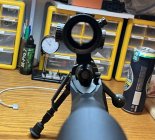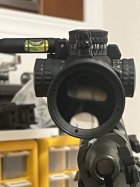Why is not not properly aligned with the bore?! See pic above
The rifle itself, which includes the barrel, has what we would call an "upright" orientation. If you look at a typical rifle from the side, the point at which the buttstock contacts the shoulder is generally well below the bore axis. Thus, the muzzle move upwards during the recoil response as the rifle rotates around an imaginary side-to-side axis located somewhere out in front of the action. This side-to-side axis is parallel to the ground (i.e. level) and at right angles with the bore axis. To this end, we want the elevation adjustment axis of the scope perfectly vertical and the windage adjustment axis perfectly horizontal. This prevents turret adjustment of elevation or windage from affecting the other. If the scope is not offset straight above the bore axis, the behavior of the rifle during the recoil impulse will not be the same in relation to the scope turret adjustments as it if the scope was directly above the bore axis because you will have had to tilt the rifle itself in order to keep the scope crosshairs "seemingly" perfectly horizontal/vertical.
As shown in your picture, I believe that by rotating rifle to the left (counterclockwise) and canting the scope to the right, you have also rotated the rifle's natural recoil impulse such that the muzzle end of the barrel will now recoil up and to the left. I believe that will cause the scope elevation and windage turret adjustments to change as I described. In other words, re-position the rifle "correctly", i.e. perfectly upright, with the scope now mounted above and to the right of the bore and see what it does to the scope crosshair. You will see that when the
rifle is positioned correctly, the scope crosshair will then be canted.
The bottom line is that this sort of exercise can be tricky. Sometimes things look a certain way to some and different to others, and it can be difficult to tell what is "correct". So by all means, don't take my word for it. Go out and test it for yourself. As I mentioned, the easiest way to do this is to zero the rifle/load at 500-600 yd, then introduce a sizeable amount of
right windage turret adjustment into the scope; as much as you can and still keep the bullets on the target. This is also the reason for doing at 500-600 yd. You want to be sure to use sufficient distance for any turret adjustment discreapncies to be readily visible of they occur. The increased distance would also better enable quantifying any observed effect and help to determine whether such an effect could effectively be ignored at shorter distances, let's say maybe 100-200 yd.
IF the way the rifle/scope are adjusted introduce cant into the scope adjustments, you should visibly observe the POI to drop lower as it moves to the right. Further, because some of the windage adjustment will have been changed in to elevation adjustement in this scenario, the POI will not move as far to the right as expected from the adjustment made. In contrast, if the POI moves the expected distance to the right AND remains at the exact same elevation, then your adjustment of the rifle/scope arrangement has apparently not introduced the cant I have described. It's a simple test, but well worth doing if you intend to continue shooting the rifle in this orientation.
Edited to add: if you look at some of the three-way adjustable rifle butt plates (link below), the pad/plate that contacts the shoulder can often be tilted/angled as you have tilted/angled the entire rifle in your picture. It's possible that tilting just the butt plate that contacts the shoulder could provide the "feel" you're looking for, without having to tilt the entire rifle. Something to consider, anyhow.
3-Way Adjustable Butt Assembly allows for vertical, horizontal and length […]

mcmillanusa.com















